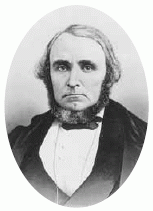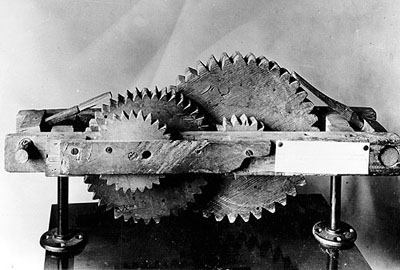William Clayton
William H. Clayton was a clerk, scribe, journalist, lyricist, and leader in the early days of The Church of Jesus Christ of Latter-day Saints. After Brigham Young asked him to report how far the pioneer train traveled each day, he created an odometer, which he called a roadometer.
Clayton was born July 17, 1814, in Penwortham, Lancashire, England. He and his parents and siblings joined the Church of Jesus Christ in 1837. He served a mission to the Manchester, England, area and then served in the British mission presidency with Joseph Fielding and Willard Richards. He married Ruth Moon in 1836 and immigrated to the United States in 1840. He farmed briefly in Iowa territory and then settled in Nauvoo, Illinois. In early February 1846, Clayton left Nauvoo with the first group of pioneers migrating to the west. After staying in Winter Quarters in Nebraska, he was part of the company that continued onto the west to find a location for the colony. He was the scribe for Brigham Young and kept a journal on the journey.
Roadometer
During his trip across the plains, Clayton was tasked with recording the number of miles the company traveled each day. He tied a red flag onto one of the wagon wheels and counted the revolution of the wheel. He would multiply the number of revolutions by the circumference of the wheel. The process was painstaking and after three weeks he sought for a easier method. Apostle and mathematician Orson Pratt helped develop a design that would use a set of wooden cog wheels attached to the hub of a wagon wheel. The company’s carpenter, Appleton Milo Harmon, built it. The wheel completed its revolution every ten miles. The device showed every quarter mile of travel. It was encased to protect it from the weather. In 1848, Clayton returned to Winter Quarters, measuring again with a new roadometer built by William A. King.[1]
The original was lost, and a replica housed in the Museum of Church History and Art did not have the right dimensions. A Brigham Young University professor (who teaches gear design) combed Clayton’s and Pratt’s journals for details and manufactured an exact replica with the help of a student.[2]
Writings
Clayton’s "The Latter-day Saints' Emigrants' Guide" is a meticulous description of the route from Winter Quarters to Salt Lake City, with suggestions for camping places. The guide had the most accurate distances available at that time. It was a valuable guide for Mormon pioneers who followed the original company, and pioneers bound for the Oregon and California territories also used it.
Clayton helped complete Joseph Smith's official history using his personal journals as a major source for many entries. Clayton's personal records were often incorporated into official scripture and history without recognition of their source. His notes were one the sources used to reconstruct Smith’s conference address known as the “King Follett Discourse.” Published sections of his journals also provide a detailed description of the Nauvoo Temple.
He was a personal secretary to both Joseph Smith and Brigham Young.
Clayton enjoyed music and played several instruments. He was a member of the Nauvoo Brass Band, which was an official musical organization of the Church. In April 1846, while camped near a creek on the Iowa plains, Clayton wrote the words to the well-loved Latter-day Saint hymn, “Come, Come, Ye Saints,” which is sung to a traditional English tune.[3]
Clayton participated in polygamy and had ten wives and forty-two children. After he arrived in the Salt Lake Valley, he ran a boardinghouse and a bookstore. He became an auditor for the Utah Territory and recorder of marks and brands, working both jobs until his death. He also worked as treasurer of the Deseret Telegraph Company as secretary for Zion’s Cooperative Mercantile Institution (ZCMI), a church based cooperative business enterprise. He worked at numerous private ventures, which included collecting debts, filing land claims, acting as a legal advocate, lending money, merchandising, farming, and mining speculation. He died on December 4, 1879, in Salt Lake City.[4]

